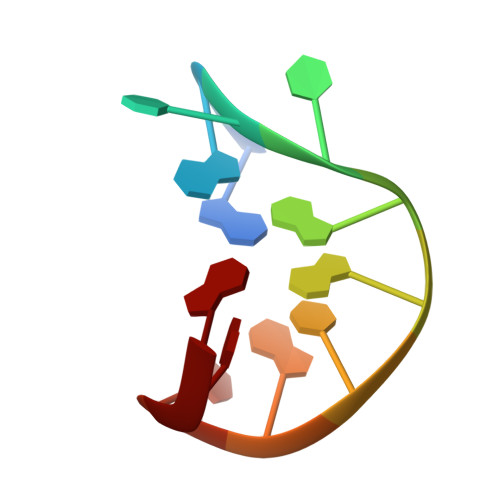G-triplex structure and formation propensity.
Cerofolini, L., Amato, J., Giachetti, A., Limongelli, V., Novellino, E., Parrinello, M., Fragai, M., Randazzo, A., Luchinat, C.(2014) Nucleic Acids Res 42: 13393-13404
- PubMed: 25378342
- DOI: https://doi.org/10.1093/nar/gku1084
- Primary Citation of Related Structures:
2MKM, 2MKO - PubMed Abstract:
The occurrence of a G-triplex folding intermediate of thrombin binding aptamer (TBA) has been recently predicted by metadynamics calculations, and experimentally supported by Nuclear Magnetic Resonance (NMR), Circular Dichroism (CD) and Differential Scanning Calorimetry (DSC) data collected on a 3' end TBA-truncated 11-mer oligonucleotide (11-mer-3'-t-TBA). Here we present the solution structure of 11-mer-3'-t-TBA in the presence of potassium ions. This structure is the first experimental example of a G-triplex folding, where a network of Hoogsteen-like hydrogen bonds stabilizes six guanines to form two G:G:G triad planes. The G-triplex folding of 11-mer-3'-t-TBA is stabilized by the potassium ion and destabilized by increasing the temperature. The superimposition of the experimental structure with that predicted by metadynamics shows a great similarity, with only significant differences involving two loops. These new structural data show that 11-mer-3'-t-TBA assumes a G-triplex DNA conformation as its stable form, reinforcing the idea that G-triplex folding intermediates may occur in vivo in human guanine-rich sequences. NMR and CD screening of eight different constructs obtained by removing from one to four bases at either the 3' and the 5' ends show that only the 11-mer-3'-t-TBA yields a relatively stable G-triplex.
Organizational Affiliation:
Magnetic Resonance Center (CERM), University of Florence, Sesto Fiorentino, Florence 50019, Italy Giotto Biotech, Via Madonna del Piano 6, Sesto Fiorentino, Florence 50019, Italy.















